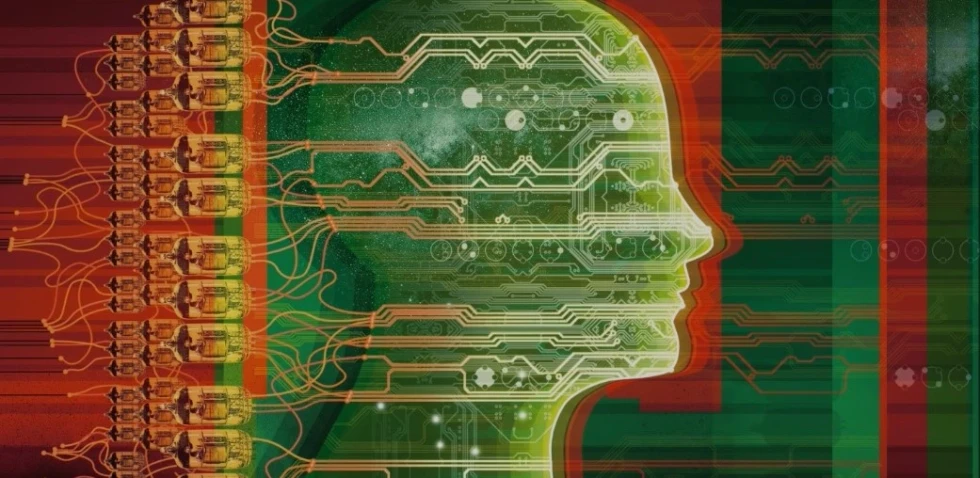AI Research
The West tries to keep up with China in the AI research race

- The US, UK, and EU are still in the AI race, but cracks are showing.
- China leads in output, patents, and talent, while the West leans on global ties.
AI has become a matter of national interest for governments worldwide, with some treating the technology as if it were like energy or defence. While China gains attention for rapid growth in the space, a closer look shows that the West – namely the US, UK, and EU – is still a major player in AI research, even if the balance is starting to shift.
A recent report by research analytics company Digital Science tracks global AI research trends from 2000 to 2024. Based on data from the Dimensions research database, the report compares research volume, collaboration, talent movement, and innovation output in different regions. Figures show that the West remains influential in AI, but also points to areas where it’s starting to lose ground.
The US holds ground but faces pressure
The United States still plays a big role in AI development. It maintains the strongest ecosystem for startups and company-led research. While the country no longer leads in the number of academic publications – that title now belongs to China – it continues to drive commercial applications of AI, especially through firms like OpenAI, Google, and Anthropic.
However, much of that research happens behind closed doors. The report notes a drop in publicly-available AI research from US firms. As companies focus more on private development, the visibility and academic impact of US-based AI research may be harder to track.
On paper, the US remains the second-largest contributor to AI research by volume. It also plays a central role in international collaboration. But even here, things are changing. China has become the US’s top AI research partner, and that relationship has continued despite rising political tension. Meanwhile, the US is more dependent on the partnerships than China, which publishes most of its research without Western involvement.
Patent filings show another area of concern to Western observers. While the US has a strong record of commercialising research, China now files about ten times more AI-related patents. That suggests the US may be publishing quality work but not always turning it into protected innovation.
UK punches above its weight
Despite its smaller size, the UK continues to perform well in AI research impact. It ranks fourth globally in attention-per-output, which measures how often a country’s research is cited relative to how much it publishes: UK research is being noticed, even if it isn’t produced in high volumes.
The UK also has strong AI hubs in London, Cambridge, and Edinburgh, with several institutions consistently publishing high-impact work. But it leans heavily on international partners to maintain that status. China has become its top AI research collaborator – accounting for over 25% of the UK’s collaborative output in 2024, more than the UK shares with the US or EU.
The country’s total number of AI researchers, about 3,000, is modest compared to China or the EU but the UK continues to attract talent and attention. The challenge is keeping the momentum going as funding shifts and global competition increases.
EU shows internal strength, external gaps
The EU-27 collectively produces a large volume of AI research, second only to China. Many of its member countries – Germany, Italy, Spain, and the Netherlands – have active research communities. EU institutions also benefit from regional programmes that support collaboration inside individual countries’ borders. That internal cooperation is a strong point.
Where the EU falls short is in visibility and conversion. Its research doesn’t attract as much global attention, and fewer projects result in patents or market-ready solutions. Only a small portion of its research output is internationally cited at high levels. The report suggests that while EU countries are producing a lot of work, they may struggle to get it noticed or applied.
External collaboration is another weak spot. Compared to the US and UK, the EU collaborates with fewer countries outside the region. This limits exposure and reduces the chance for shared development with global leaders in AI.
The EU is also fragmentated. While there is internal cooperation, there’s less clarity on a unified AI strategy in the bloc. That leaves some research institutions without the scale or coordination needed to compete with larger players.
Talent is moving, and the West is losing
One of the more striking data points in the report involves international moves by researchers. In the past, Western countries were top destinations for AI talent but that pattern is changing.
China now has a net gain in the number of AI researchers from the US, UK, and EU. In other words, more researchers are moving to China than leaving it. Meanwhile, the West is still drawing in international talent, but it’s losing some of its own experts in return.
The US remains the largest source and destination for AI researchers globally, but its net balance has shrunk. The UK and EU are also sending more talent abroad than they’re getting back. The raises questions about how long the West can maintain its research base without stronger local investment and retention.
Institutions in the West still matter
While the report focuses on national output, it also highlights standout institutions. The US is home to several high-output AI institutions, including top universities and research labs. The UK has 19 institutions that each published over 50 AI papers in 2024. In the EU, that number stands at 54. For comparison, China has 156 such institutions.
The disparity shows that while quality exists in the West, it’s less evenly spread. China’s broader base gives it more resilience and reach. The US and EU have high-performing research centres, but they tend to be more concentrated.
Collaboration patterns are shifting
International collaboration has long been a strength of Western research. The report confirms that trend but adds an important caveat: while the West is collaborating more, it’s also growing more reliant on China.
In 2024, China was the top AI collaborator for the US, UK, and EU. But China does not rely on those same countries to the same extent. Just 4% of China’s AI research included collaborators from the West. That number was 25% for the UK and about 10-12% for the US and EU.
The imbalance suggests that China has positioned itself as a connector – but one that can also work alone. The West, in contrast, depends more on external ties to maintain research output and influence.
Looking ahead
The West is still in the AI race – but it may need to rethink its strategy. While the US, UK, and EU have strong research histories, high-impact institutions, and skilled talent, those advantages are being tested.
As China expands its AI base, builds long-term talent, and dominates in patents, Western nations may need to focus less on volume and more on outcomes. That includes better research-to-product pipelines, more inclusive collaboration networks, and policies that keep talent from drifting elsewhere.
The gap isn’t yet unbridgeable – but the numbers show it’s widening.
AI Research
KAIST researchers develop AI technology to restore blurry video images – CHOSUNBIZ – Chosun Biz
AI Research
From postmodernism to artificial intelligence

Postmodernism can also be read as a prophecy. It denied inspiration and promoted combination. Postmodernism as a combinatorial art has brought the algorithmic model ChatGPT. This new machine surpasses even the most encyclopedic postmodern writer. Therefore, there is no point in competing with technology in the work of information. We were lucky to be the smartest on the planet. Now we must accept that AI is ahead of us
Albanian literature of Kosovo is a new literature, after the Second World War. But, it is only a branch, which is naturally linked linguistically and literaryly to Albania, as well as to the Albanian part of Montenegro and Macedonia, and of course also to the Diaspora. There have been and continue to be voices that insist that the literature of Kosovo is independent of the literature of Albania, and vice versa. So, Albanians with two states have two literatures, while the United States of America with 50 states has one literature. A provincialist voice that is not taken seriously today.
However, at a time when Kosovo and Albania were also part of the Communist Bloc, although separately, the official method of literary writing was socialist realism, but since Kosovo was included within Yugoslavia, there was greater freedom of writing, thanks to the Croatian writer Miroslav Kërlezha, who, being the president of the Writers’ League of Yugoslavia and an indisputable literary authority, managed to make the official method optional, not mandatory. So, the preferred method was socialist realism, but others were also allowed. Taking advantage of this freedom, since the 60s, in Yugoslavia we have novels like those by Danillo Kishi, “Attic”, “Psalm 44”, and later “A Grave for Boris Davidović”, “Encyclopedia of the Dead”, etc.
The most famous novel of Kosovo
In this free atmosphere for narrative experiments, the first practices of an alternative aesthetic in Kosovo also appeared. In the magazine “Jeta e Re”, from the first issue of 1972 to the first issue of 1974, stories appeared whose author was an unknown name in Kosovo: Luan Dukagjini. No one knew this name, except for the founder and publisher of the magazine, Esad Mekuli, who kept the author in complete secrecy. Only after the stories were published in the magazine and aroused a double interest: for the new storytelling model and for the unknown author, was the issue resolved, by publishing all the stories in a book with the author’s real name: Rexhep Qosja, “Death Comes to Me from Such Eyes”, thirteen stories that could make a novel. So, behind the mask of an unknown author, he was the most famous author in Kosovo, about whom critic Ali Aliu says that even his studies were read more than the prose and poetry of other Kosovar authors.
Rexhep Qosja did not hide behind the pseudonym for political reasons, but because he thought that, being already known as a professor and researcher, he would not be taken seriously in prose. This fear of moving from the academic world to the artistic world has been shared by many others, including Umberto Eco, because people who are known for works of consciousness are afraid of suddenly moving into works of the subconscious. They consider themselves more scientists than writers. So, they want to be known as knowledgeable, not as stupid.
Thus, postmodernism entered Albanian literature with great hesitation, but in a natural flow. A man who was known as a scholar, became a writer. There was no better way, when it is known that this formation has its strongest point in knowledge (information). Talent and inspiration alone are not enough to be a postmodernist. Knowledge, preferably encyclopedic, is a necessary condition. Thus, it was necessary for someone who had completed studies, had earned titles, and had accumulated knowledge, to be able to bring this poetics among us. So, it was no coincidence that this man brought this model to Kosovo and became not only the founder, but also the main representative in Albanian literature. And it is no wonder that, to this day, “Death Comes to Me Through Such Eyes” is the most translated novel from Kosovo. So, for more than half a century this is still the most famous novel from Kosovo.
In the 70s, Qosja dominated as a writer of prose and drama. In the 80s, due to the worsening situation, he returned to the role of scholar and public intellectual.
In Kosovo, the postmodernist model of the writer coming to the field of fiction from epistemological fields only re-emerged in the 90s with Kujtim Rrahmani, who had begun his career as a researcher. This trend continued into the 21st century, when researchers moved into prose: Agron Y. Gashi, Gëzim Aliu, Adil Olluri, and others.
In Albania, postmodernism was unimaginable before the 90s. Just take a look at Vath Koreshi’s essays written during the dictatorship. Meanwhile, during the 90s, new prose writers emerged who embraced the postmodern model, such as Ridvan Dibra and Agron Tufa, or even two others who came from the world of film (screenwriting): Bashkim Hoxha and Bashkim Shehu. Surprisingly, this model also attracted the author Vath Koreshi, who once publicly reviled postmodernism. There were also authors who had started out in communism, but quickly switched to the new model, such as Zija Çela and Besnik Mustafaj. This model did not even leave the most famous Albanian writer, Ismail Kadare, indifferent, who was not very concerned with fashion. Meanwhile, in Macedonia, two works appeared that can now be considered classic works of postmodernism, “The Time of Goats” (Luan Starova) and “The Years of Urith” (Kim Mehmeti).
This means that a literary model, welcomed by readers and ignored by scholars, became dominant in Albanian literature at the end of the 20th century, and continues to this day. Even the most beautiful postmodern novels were written in this century by authors such as: Ridvan Dibra, Agron Tufa, Besnik Mustafaj, Stefan Çapaliku, Durim Taçi, etc.
Heresy and the Inquisition
We must not forget that Kosovo’s literature, until the postmodern alternative was found, was written either with a simplistic and traditional realism, or with a “psychedelic modernism”, trying to graft European modernism (Proust, Joyce, Kafka, up to Alain Rob-Grillet, Nathalie Sarraute, Claude Simon) with the modernism of pre-war Albania (Koliqi, Kuteli, Fishta, Migjeni, etc.). Thus, the two best modernist authors of Kosovo, Anton Pashku and Azem Shkreli, one in prose, the other in poetry, brought ethno-modernist works, that is, a modernism with a twist. Pashku between Koliqi and Claude Simon, Azem Shkreli between Migjeni, Martin Camaj and Vasko Popa, whom he also translated. While Migjeni is a frequent reference to Shkreli, while Camaj mainly in the wisdom of the highlander, the shadow of Vasko Popa appears in his best poems. Just read them one after the other: “Instead of Greetings” (Shkreli) and “Let’s Get My Pieces Back” (Popa).
Meanwhile, Rexhep Qosjen, who was not impressed by Albanian modernism, neither the pre-war one in Albania nor the post-war one in Kosovo, as can be seen from his novel, and as he says in his diary, was particularly impressed by Danillo Kish and Kurt Vonnegut, who at that time was quite translated and well-known in Yugoslavia. In this way, the postmodern alternative was a kind of aesthetic heresy. And it was normal for the heretic to talk about persecution by the Inquisition, which monitored the intellectual like a Big Brother. Therefore, the title could also be “Death Comes to Me from the Eyes of Big Brother”.
This alternative, this heresy, was necessary for Albanian literature. It overturned literary monism (modernist, or socialist realist, it doesn’t matter) and promoted pluralism. Many writers from Kosovo, Albania and Macedonia joined this heresy, while Montenegro has the merit of bringing our first heretic. So, in a way, all the pieces of Albanian lands were united. This is a fact, however, the last thing postmodernism would like to promote is patriotism.
Although ignored by Albanian literary criticism, which was completely unprepared to follow the rapid pace of literary change, postmodernism changed the face of Albanian literature. This change was made both in terms of structuring and in the way of communication. Paradoxically, writers abandoned hermetic modernist forms, through double coding. While, for example, Pashku’s novel was barely decipherable by specialists, Dibra’s novels are understood by both types of readers: specialists and amateurs. So, while Pashku barely penetrated a type of reader who, when unable to decipher, invented the meaning, because the reader has the right to invent the meaning, in Dibra the elite reader has fun decoding the semiotic line, while the popular reader (the one who reads just to pass the time) has fun with the semantic line. Let’s not forget that Albanian literature had reached the point where it was easier to understand Proust, Kafka, Joyce, TS Eliot, Faulkner than the Kosovar modernists. On the other hand, as soon as you read any discursive writing by these people, you realized that their education was very modest. I think this only happens to poser writers, not real ones. Paul Valéry is a genius in poetry, prose and essays, even in occasional speeches. You can be a genius in something and mediocre in something else, but not a genius in prose and an idiot in essays, for example. Therefore, I suggest that when we like an Albanian poet or prose writer, we also read his essay writings, before forming an impression of him. This is not always the clearest indicator, but in most cases, it helps a lot.
So, postmodernism has great merit for the survival of the reader, who was in his last moments due to fatigue from socialist realist literature and lack of communication with modernist literature. On one side there were extremely open works, and on the other side there were hermetically closed works. Albanian postmodern authors, with alternative poetics, created two types of readers, of which the semiotic reader was often profiled as a critic. And, in this way, the author created the model reader, while the reader the model author. The postmodern author has saved, entertained, formed and emancipated the reader in general, while he has also familiarized the new reader with new techniques and notions.
Postmodernism and criticism
Until the end of the first decade of this century, one could not speak of criticism of postmodernism, but only of criticism of postmodernism. Since structuralist criticism was applied, the postmodernist paradigm was rejected. However, in the meantime, new voices of scholars emerged and master’s and doctoral theses began to be defended, and books were written on postmodern works and phenomena, consequently new approaches began to appear, with a different terminology, completely different from that which analyzed modernist texts. Many novels appeared as found manuscripts, while the author as a discoverer and commentator of them, such as, for example, Vath Koreshi with “Ulku dhe Uilli”, Rexhep Qosja with “Një dashuri dhe shtëtë faje”, or Agron Tufa with “Gurit të varrit ia rrëfej”. Also, Qosja’s prose, like that of Dibra, was distinguished by the frequent use of anaphora and enumeration. While, almost all authors played with historiographic metafiction, double coding, poioumenon, intertextual irony, collage, bricolage, pastiche, etc., and this created a postmodern condition, which displayed distrust in all metanarratives, and also included gynocentric discourse to destabilize patriarchal and androcentric discourse, in general. This category includes novels and stories by authors such as Flutura Açka, Besa Myftiu, Rita Petro and others. I would like to list many poets here, but poetry is not a representative genre in postmodernism.
In the 90s, when Albanian postmodern works flooded in, people started talking about the death of postmodernism in Europe. In 2008, Raoul Eshelman published the book “Performatism, or the End of Postmodernism”, while in 2009, Alan Kirby published the book “Digimodernism, How New Technologies Dismantle the Postmodern and Reconfigure Our Culture”. In 2010, I published a sketch of the end of postmodernism. This sketch was expanded in the meantime, and in 2017, it was published in English and in several languages and magazines, under the title “The End of the Age of Endings”, and this year it is also being published as a separate book. Usually, I am not self-referential in criticism, but I mentioned this to show that we, Albanians, have also begun to say goodbye to postmodernism, and, as they say today, we have coordinated with foreigners before going to the funeral ceremony of this formation, which remains the last ‘ism’ accepted by foreign scholars. Some scholars and artists have also proposed names for the new era, the era that comes after postmodernism: post-postmodernism, trans-postmodernism, post-millennialism, performatism, digital modernism, metamodernism, stacism, remodernism, altermodernism, hypermodernism, etc., but also other names and manifestos, related to a certain field, that contribute to, or compete with these concepts, such as: New Sincerity, New Puritanism, Dogma 95, etc. I think that the term Hysterical Realism used by James Wood, helps a lot in distancing ourselves from postmodernism. This year marks a quarter of a century since this term was first used, and authors themselves have begun to be more careful not to categorize themselves within it.
Now theorists say that postmodernism has ended, while we see that Albanian writers continue to write postmodern works. However, in the last decade we see that some authors are successfully distancing themselves from postmodernism, since in their narratives either sincerity or emotion dominates, or both. Postmodern work, in its best manifestation, was rational, rarely had emotional elements. Now the narrative has been personalized, autofiction has become dominant. So, we see a retreat of postmodernism to make way for a new current, or spirit.
It is now clear that even in Albanian literature, postmodernism is in its final stages. We are now at a time when we can divide writers into dinosaurs and chameleons. That is, into those who die as soon as their poetics are finished, and into others who adapt to new poetics, even leading to poetics that have not yet arrived. New poetics are created either by completely ignoring old poetics, or by taking from them marginal elements and turning them into central ones. The latter is happening in Albanian literature.
Results register
As proof that postmodernism has been present and successful for half a century, are the names of prominent authors and their works. One cannot ignore a formation that has brought works such as these: “Death comes to me from such eyes”, “A love and seven sins”, “The night is our day”, “Nude”, “The legend of loneliness”, “In search of the lost child”, “Sleeping on the snow”, “I tell the tombstone”, “The Chronicles of the fog”, “The time of the goats”, “The years of the urith”, “Each goes crazy in his own way”, “Born backwards”, etc. Another element that unites Albanian postmodernism is the theme of communism, treated by Qosja, Starova, Mehmeti, Dibra, Tufa, Çapaliku, Shehu, Hoxha, Açka, Petro etc. But, perhaps communism is the most generally treated theme in contemporary Albanian literature. It can be freely said that he is its main theme.
That postmodern authors have enriched Albanian literature, in many aspects (thematic, stylistic, formal, philosophical, etc.), is today indisputable. But why was postmodernism received with kicks from the departments and critics? Because one thing was not understood: that literature does not progress, but only changes. The reader gets tired of one form and seeks another. Poetics that are closed are not thrown away (not even socialist realism, which in the history of literature is the most politically instrumental); they are only conserved, turned into classics. Postmodernism, like modernism and all other isms, is not a value, but a new form of expression. Therefore, even the most postmodern works of an author do not mean that they are his best. For example, Qosje’s most postmodern work is “Nobody’s Sons”, but it is not the best (the first three novels are much better); the novels about Gjergj Elez Ali by Ridvan Dibra are the most postmodern, but not the best (“The Legend of Solitude” and “Sleep on the Snow” are much better); the novel “I Tell the Gravestone” by Agron Tufa is the most postmodern, but not the best (“Black Friday” is much better); “An Impossible Novel” by Besnik Mustafaj is the most postmodern, but not the best (many of his other novels are better), and so on. Perhaps only “Ulku dhe Uilli” is the best and most postmodern novel by Vath Koresh.
So, what criticism should have understood and then supported is the fact that poetics (models, paradigms, formations, currents) come back into fashion for a while, but this does not invalidate the old ones. It is ridiculous to think that any contemporary writer is better than Homer, Aeschylus, Dante, Shakespeare, Goethe, or Gogol. Beyond poetics, beyond forms, writers are valued for the depth of reflection, the beauty of expression, and vision. They do not simply bear witness to an event. No. They reflect on the event, tell it in a specific way, and from it derive messages for the present and the future. Poetics unites writers of a time or a place, while what separates them from each other is precisely the authenticity thanks to which they occupy an eternal place not only in literature, but in the history of civilization. As Ezra Pound says: a civilization is founded on Homer.
So, it should be clear that postmodern authors are not better than modern authors, or that today’s authors are not better than those of yesterday. Not at all. Model and value are two things. Each time has its own fashion, but when we compare beyond fashion, that is, only what is deep, philosophical, or spiritual, we cannot help but agree with the painter Marc Chagall who said: what value is the Pope’s expensive suit compared to the rags of Christ?!
We must always be aware of this.
Postmodernism and ChatGPT
Postmodernism can also be read as a prophecy. It denied inspiration and, instead, promoted combination. Almost all postmodern theorists and writers agree that literature is an ars combinatoria. So, postmodernism was the master of combining information. Towards the end of 2022, ChatGPT was invented, as a generative artificial intelligence. A few years ago, I said that the death certificate of postmodernism should include the date of Umberto Eco’s death (February 19, 2016). He was an information machine before the invention of this artificial platform. But an author who writes postmodern works after 2022 cannot be taken seriously, and even deserves to be reviled as a hysterical realist, or as Don Quixote. ChatGPT has already replaced the scribblers (requests, recommendations, descriptive articles), as well as the average writer and translator.
Postmodernism as a combinatorial art has brought this algorithmic model. Once the competition in literature was only between people, now we have a new competition, with Artificial Intelligence (AI). As for information, this new machine surpasses even the most encyclopedic postmodern writer. Therefore, it makes no sense to compete with technology in the work of information. We were lucky to be the smartest on the planet. We must now accept that AI is ahead of us, and that, as one of the CEOs said, no child born from now on will be more intelligent than Artificial Intelligence. Kazuo Ishiguro (“Klara and the Sun”, 2021) and Olga Ravn (“The Employees”, 2020) have already successfully thematized this new challenge: humans versus humanoids.
Let’s not forget that postmodernism was information. Now information has been taken over by technology. We know the challenge that awaits us, but we don’t know how we will face it as writers. In an interview towards the end of his life, Martin Heidegger said that cybernetics will replace philosophy. What artificial intelligence will do to literature is difficult to say today, but let’s ask: Will there be a second death of the author, after what Roland Barthes declared (La mort de l’auteur, 1967)? Will the book be written by AI, or by me? In what way am I better than AI? Since I have invented something that is more intelligent than me, will AI be able to invent something more intelligent than itself?
These will be the questions that will become dominant themes in tomorrow’s literature. So, for everything we ask today, we will receive the answers tomorrow. Meanwhile, since narration is an anthropological necessity, man will walk through the narrative forests of three worlds: the material world, the spiritual world, and the artificial world.
Lecture read at the International Seminar on Albanian Language, Literature and Culture, on August 27, 2025, at the Faculty of Philology, University of Prishtina. Published with permission of the author.
AI Research
Lessons from 60 Years in Journalism — A Postscript on Artificial Intelligence – TAPinto
-
Tools & Platforms3 weeks ago
Building Trust in Military AI Starts with Opening the Black Box – War on the Rocks
-

 Ethics & Policy1 month ago
Ethics & Policy1 month agoSDAIA Supports Saudi Arabia’s Leadership in Shaping Global AI Ethics, Policy, and Research – وكالة الأنباء السعودية
-

 Events & Conferences3 months ago
Events & Conferences3 months agoJourney to 1000 models: Scaling Instagram’s recommendation system
-

 Business2 days ago
Business2 days agoThe Guardian view on Trump and the Fed: independence is no substitute for accountability | Editorial
-

 Jobs & Careers2 months ago
Jobs & Careers2 months agoMumbai-based Perplexity Alternative Has 60k+ Users Without Funding
-

 Funding & Business2 months ago
Funding & Business2 months agoKayak and Expedia race to build AI travel agents that turn social posts into itineraries
-

 Education2 months ago
Education2 months agoVEX Robotics launches AI-powered classroom robotics system
-

 Podcasts & Talks2 months ago
Podcasts & Talks2 months agoHappy 4th of July! 🎆 Made with Veo 3 in Gemini
-

 Podcasts & Talks2 months ago
Podcasts & Talks2 months agoOpenAI 🤝 @teamganassi
-

 Mergers & Acquisitions2 months ago
Mergers & Acquisitions2 months agoDonald Trump suggests US government review subsidies to Elon Musk’s companies





















